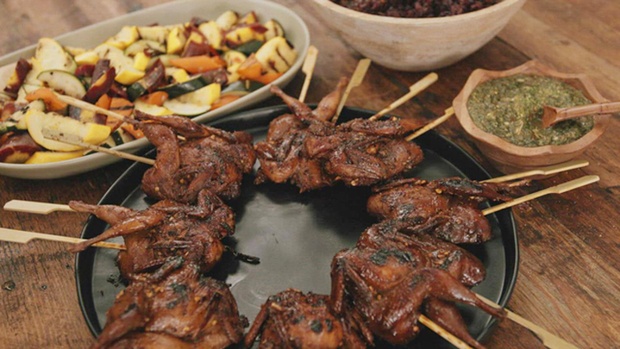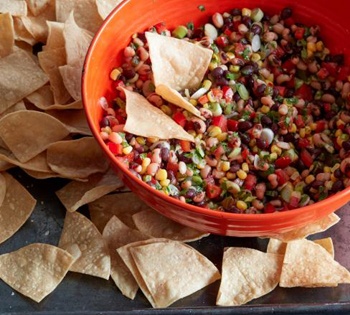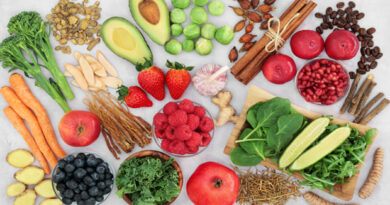Biggest Food Trends You’ll See in 2023
Biggest Food Trends You’ll See In 2023
What will we all be cooking and eating in 2023? There’s a lot of food trends to think about this time around. We’ve weathered a pandemic and are all thinking about ways to recover and find joy through food. Environmental concerns are more present than ever before. TikTok has become ubiquitous, skyrocketing Gen Z creators to fame and changing the way food trends start and spread. While trendiness feels like a trend, with dishes like butter boards everywhere one week and forgotten the next, it’s hard to drill down to what will be the overarching food trends that’ll be everywhere in 2023. Below is what Food Network editors have come up with.
We’re All Craving Nostalgic Food
Since the pandemic, many Americans, particularly content creators, are turning to the brands and dishes that remind them of simpler bygone times. Apps like TikTok, which encourage recreating trends like the viral dirty shirley (pictured above) have crystalized this focus on childhood and past eras — though what’s nostalgic to each person totally varies — from apple hand pies to halwa to pizza toast and everything in between. Brands are tapping into nostalgia too; s’mores flavored foods were big at this year’s Sweets & Snack Expo, for example.
Just Add Water
Look closely and you will notice more foods and cleaning products are being sold as powders or pastes. Consumer packaged goods companies are using less water — or none at all — to cut down on shipping costs, greenhouse gas emissions and packaging and to conserve water. Case in point: Kellog’s recently released just-add-water cereal bowls “Instabowls,” which contain powdered milk. And some products, like those from Omsom (pictured above), an Asian-American brand started by sisters tired of the not-so-inspiring dinner shortcuts in most American grocery stores, provide concentrated punches of flavor that make dinner just as delicious as it is easy.
What to Know about Honey Alternatives
More Americans today are exploring vegan cooking; according to the Good Food Institute, the sales of plant-based foods grew three times faster than overall food sales in 2021. Vegan honey alternatives, or ingredients that can be substituted for honey 1:1, comprise a growing category, driven in part by bee colony collapse disorder. Look for new products made from ingredients like cane and coconut nectar, as well as some that focus on ingredients that have existed for hundreds of years like date syrup (pictured above). As more products come on the market, we expect recipes, to start specifically calling for honey alternatives.
Steam Ovens Are the New Air Fryers

Sales of combi ovens (ovens that cook with steam and convection) grew globally 10.2% year-on-year in 2022. For the second year running, Zillow found steam ovens to be the number one item to boost the value of a home, with those homes selling for 3.7% more than expected on average. Steam technology is being incorporated into all sorts of oven appliances, such as the Ninja Speedi Rapid Cooker and Air Fryer and the Tik Tok-famous Balmuda Steam Toaster Oven (pictured above) in order to crisp food while maintaining its fluffy interior. As more appliances integrate steam technology, prices will come down and home cooks will use it regularly, in the same way they adopted air frying.
Restaurants that Feel Like Dinner Parties
During the pandemic, as restaurants shut down and people trusted only their close friends, dinner parties were prevalent. Now, everyone is busier and looking to socialize and meet new people. Enter the dinner party-style restaurant and supper club, which promises to create the party vibes for you with communal tables and food served family-style. For example, Cloth & Flame throws dinner parties in all 50 states designed to bring communities together over innovative cooking. Pictured above is one of their dinners in the Arizona desert town of Arcosanti. Even if a dinner party restaurant doesn’t open in your town, expect to see restaurants incorporating elements that bring people together like communal tables or welcome drinks.
Tamarind Is the Ingredient of the Year
Tamarind is a culture-spanning ingredient that, while native to Africa, is popular in multiple cuisines, including Mexican, Indian and Southeast Asian. The mouth-puckery fruit is often sold as pods or a paste in various sweet-sour-tangy-tart formulations. It’s taking off in the U.S. in sweets, snacks and beverages because Gen-Z’ers just so happen to have a penchant for big, bold, unique flavors, especially ones that are international. In the past year, Banderilla Tama Roca Tamarindo Mexican Candy Sticks has been a breakout term in Google, meaning the search term grew by more than 5,000%. Tangy Tamarind Doritos’ launch in summer 2022 marks the first tamarind-flavored salty snack by a major US snack brand. For some tamarind cooking inspo, check out our Bhutta Bhel, Tamarind Pineapple Quencher and One-Pot Mushroom Biryani with Tamarind and Coconut Milk.
Live Fire Cooking

Live fire cooking is a broad term that refers to cooking food over embers, AKA wood that has burned down into white ash. It’s a method that spans cultures and millennium and includes, among other techniques, grilling, cooking over a campfire and spit roasting. Many restaurants are installing wood-fired ovens and grills. Simultaneously, networks and authors are creating live fire cooking content. In Food Network’s digital video series Stoked, for example, Chef Yia Vang celebrates the legacy of making wood fire grilled Hmong food ranging from Spatchcock Quail (pictured above) to Tiger Bite Hot Sauce. Home cooks are become interested in trying their hand at live fire cooking. Interest in outdoor project cooking is spiking, with people investing in outdoor cooking stations, Ooni Pizza Ovens and Blackstone Griddles.
Should You Be Zhuzhing Food?
The origin of the word is not completely known, but some trace it back to early 20th century. More recently, a version of zhuzh (jueje) was made popular in the early 2000s. Garnishing used to be a step reserved for chefs in pricey restaurants. But with the proliferation of all-purpose seasonings — like everything bagel and togarashi — people are sprinkling, dusting and drizzling their way to better tasting meals at home. Now, zhuzhing is a mode of cooking for many people — and an especially visual way to finish dishes on social media, where balsamic drizzles are popular. There are more and more toppings available for zhuzhing savory dishes (check out Food Network Editors’ favorite ways to zhuzh up meals) and let’s not forget the sweet ones (here are nine ways to zhuzh up hot chocolate).
The Rise of International E-Marketplaces
Many big box grocery stores have limited shelf space, making international ingredients hard to find — yet there’s high demand. International e-marketplaces are growing and have massive reach and major money behind them. Some, like Weee! and Tocabe are startups, while others are direct to consumer extensions of big brands like Goya, which launched an online marketplace in September to sell its Latin food products directly to the consumer. Thanks to social platforms like YouTube and TikTok, home cooks can follow creators who make content that feels authentic to their backgrounds and identities. Recipes like silken tofu banchan (pictured above), a Korean recipe that involves dumping soft tofu from its package and dressing it with a soy sauce-based topping, are going viral on Tik Tok because of their ease and big flavor. As shoppers learn about new global ingredients, they continually broaden what they consider to be pantry and fridge staples.
Viral Middle American Dishes

After people moved away from coastal cities during the pandemic (the U.S. Census Bureau 2021 Vintage Population Estimate Report recorded that both Cupertino, California and New York City’s population declines were amongst the highest in the country), a lot of the trends started coming from middle America. People are obsessed on a national level with dishes that once only existed in specific regions of the country such as dirty soda, cowboy caviar (pictured above), trash plates, Shaker lemon pie, crunchy buckeyes, chicken riggies and more. Expect to see food buzz coming out of Michigan’s Traverse City (searches for the city’s cherry festival were breakout in 2022). People were also really excited about the Minnesota State Fair food — pickle pizza in particular experienced all time high searches.
Better-for-You Recovery Beverages
“Recovery” is the catchword that has taken over the wellness industry. It has broad appeal — from mental health to gut biome to post-workout or post-drinking hydration. A bevy of new recovery products, mostly drinks, have better-for-you, plant-based ingredient lists and are designed to help with immediate recovery post workout or drinking. Research supports recovery beverages with a carbohydrate-to-fat ratio of 4:1 (3:1 is also acceptable) within a 120-minute window post workout. As some Americans are learning to pause and care for themselves, more CPG companies — across all categories — will offer a hand in recovery.
Parents Want Sustainable Kid Food
In past years, terms like organic and sugar-free have been prevalent buzzwords on kids’ food packaging. At the 2022 Fancy Food Show, we saw three labels taking center stage: upcycling, regenerative farming and net zero. According to Innova Market Insights’ 2022 Lifestyle & Attitude Survey, for the first time ever, more consumers surveyed globally said the health of the planet was their top global concern instead of the health of the population. And products with environmental claims are growing at three times the pace of total food and beverage activity. As environmentally conscious branding becomes ubiquitous in kid food and beyond, it’s important to read the fine print. The rules about corporate pledges are still being formed, and while some companies are in fact doing good, others are greenwashing — or making deceptive claims about their environmental impact. It’s important to take a second to look into, say, the year by which a company pledges to reach net zero carbon emissions, as it could be 60 years into the future.
READ: Game Changer for Type 2 Diabetes
– Heath Goldman for Food Network Kitchen | www.foodnetwork.com





